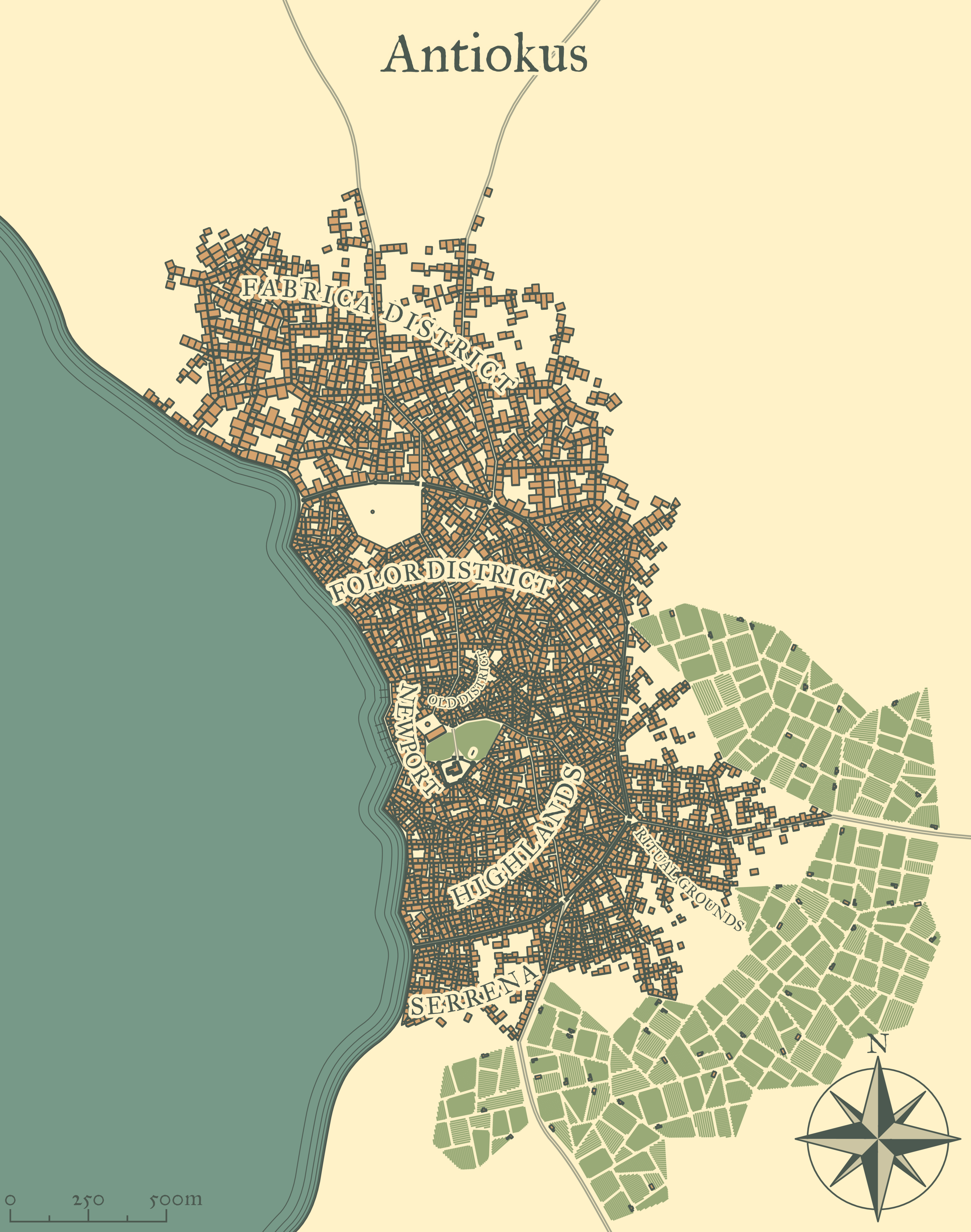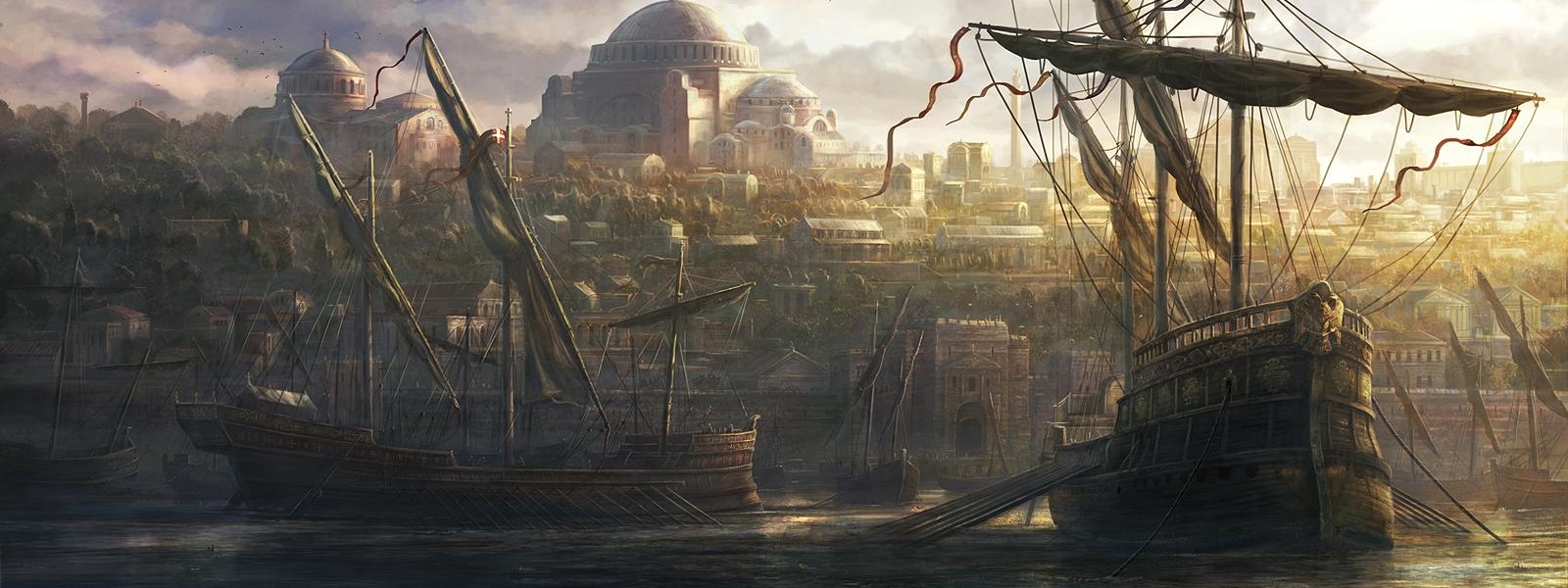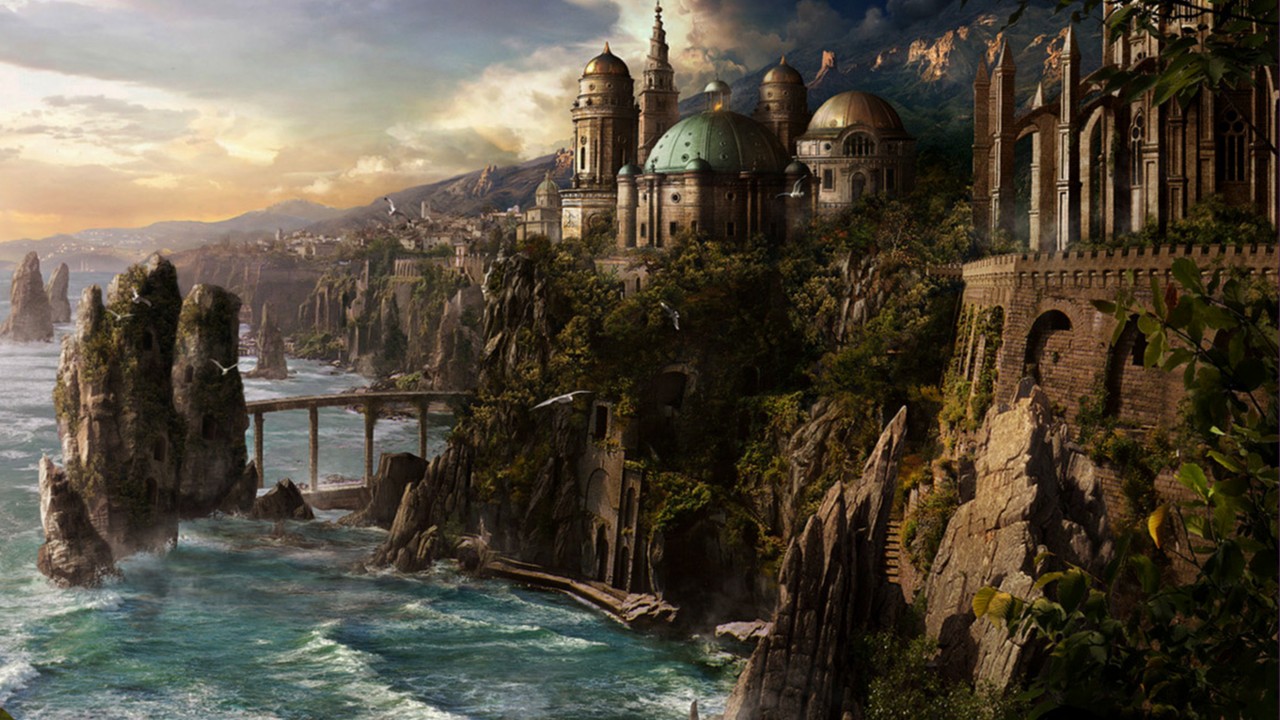Antiokus (/antaiokus/ (Aeillan: /antiokos/))
As you approach the city, its most notable feature becomes readily apparent. At first glance it appears to have been built on a cliffside, but a closer observation reveals the numerous chunks of ruined masonry and edifice sitting in the harbor and hasty constructions built into the cliffside itself. The city of Antiokus is perhaps most infamous for its drowning in one of the most powerful acts of magic in since the ancient days, and looking upon the cliffs you see scars of that act of hatred even centuries later.Antiokus is an old coastal port city built towards the eastern edge of the Menaulatolia. It is the largest single city in the Exarchate of Korentis, and the base of power for the largest and most influential body in the state aside from the Exarchate itself. The city of Antiokus is most famous for its status as a major center of the Feloran colonizers during the Feloran Invasionary period, and the subsequent drowning of much of the city by Aeillans. To this day "May your Children Rest in Antiokus" is used as racial animus against elves by those familiar with the incident.
Wards of Antiokus
Antikus is divided into seven distinct wards of these wards, only three were constructed before the Drowning of Antiokus. The others were built by Aeillans moving back into the area after much of the city was cast into the sea in that event, and one is a recent development at the hands of manufactories seeking to make use of the archaeological wealth just off the coast. These newer neighborhoods are outside the old walls of the city.Newport. Built out of the remains of the Old Palace War, Newport serves as the economic hub of the city, with port facilities, serviced by the Great Elevator, as well as smaller docks servicing prospectors seeking to pick through the ruins in the bay bring in much of the nonagricultural economic activity. The Megatrapeza, one of Aeilla's most important financial institutions too resides here, as well as the Temple of Victory, and Victory Square which serve as the cultural heart of the city.
Old District. Home to the ancient and wealth families of the city the Old District was one of the few communities within the city to survive the events of the Feloran Invasionary Period relatively intact, and as a result is home to those who have longstanding influence and indeed those who adventure can find very powerful patrons here.
Highlands. Damaged heavily by the events of the Drowning, the Highlands were rebuilt in the years following the fall of the Aeillan Empire. It is here that the real political power flows as the military is based here, along with the office of the Tourmarch and many military fabricae supplying the city's armies with most of the equipment they need for battle. This repurposing has left the district somewhat empty and bereft of culture as wandering patrons and street merchants are replaced with patrols of soldiers and guards.
Folora. Initially a part of the Old District, the Folora Ward was remade in the image of Feloran cities during the Invasionary Period and many of the city's wealthy were cast out as a result. Though the ward was spared the worst of the Drowning of Antiokus, but was utterly devastated in the Great Purge following Elven withdrawal from the region. The destruction wrought by that event laid waste to all but the most resilient of buildings. In the centuries following, the area was rebuilt in a more traditional Aeillan style, though one can still see Elven influences peeking through more modern construction.
Serrena. Built by the nobility whose homes had been destroyed by the Drowning, the Serrena is a wealthy neighborhood, consisting noble estates connected to highly productive farmland nearby. In recent years this area has started to go into a genteel decline as manufactories begin to spring up in the northern outskirts, but remains relatively prosperous.
Ritual Grounds. Allegedly built upon the site where the spellcasters responsible for the Drowning, the Ritual Grounds is a relatively poor neighboorhood, but is home to an unusually large number of temples built in commemoration of that event and the 'deliverance' of the Aeillan people from foreign occupation.
Fabrica District. The most recent addition to the city, the Fabrica District is built up around the concentrated manufactories as people move into the city in modern times, and away from the violent frontiers. This area has been increasingly economically powerful as the trade guilds established here have seen a boom in prosperity.
Important Locations
The Temple of Victory. Built out of the hollowed out remains of an old Feloran Temple established as they colonized the region. The Temple of Victory has become a powerful cultural symbol of Aeillan victory against the invaders. Serving both as a religious and scholarly institution, most of the Temple has been taken up with a museum displaying a number of artifacts from the time period.The Great Elevator. An enormous construct built to bring cargo up from the ports butting up against the cliff faces of the city, the Great Elevator is one of the greatest feats of Aeillan engineering since the fall of the Empire. Powered by dozens of oxen, the elevator is responsible for moving vast quantities of goods into and out of the city on a daily basis.
Megatrapeza. One of the largest and most important financial institutions in Aeilla, the Megatrapeza is one of the chief financiers of several mercenary companies in the region, and wields enormous power. Many Tourmarches of Antiokus are quick to make friends with the bank so that they can procure far more resources for their army than they otherwise could.
The University of Antiokus. The premier archaeological university in Aeilla, this school was established primarily to study the ruins left behind by the Drowning. Many bright minds have come from this university, including a few wizards who are uniquely gifted in the art of producing magic items. The university is also known to pay handsomely for ancient artifacts from elven, Yulan-Tai, and Nimeaeran civilizations as well as from the deserts of Qua'adar.
Cuthroat Alley. In the belly of Folora, one can find Cutthroat Alley, a black market that deals in illicitly obtained magical goods. The Black Fleet is known run most of the mana potions sold to Aeillans through this point. It is believed a connection to the Ancient Path can be found here.
Shipwreck Tavern. Constructed from the wreckage of several ships destroyed in the drowning, Shipwreck Tavern is a major bar for sailors, thanks in large part to its prime location next to the Great Elevator. The Shipwreck is known for a cantankerous crowd, and is a good place to look for a ship for hire.
Demographics
The city of Antiokus has a population of 72,215 residents as of the most recently available records. Most of the population, 61,000 people are noncitizen freemen of the Exarchate of Korentis with over 9,000 being slaves. Only a small handful of the population, fewer than 1,500 are legitimately citizens of the Exarchate and most of these are nobles. Most of the population consists of Gitoxoi, and Aeillan humans with an unusually high number of the former. Smaller smatterings other kinds of humans, and nonhuman sentients make up the rest of the population. However, most populations aside from ethnic Aeillans tend to be transient in nature.
Government
The government of the city of Antiokus is nominally a provisional city council made up of the notable population in the city. This council is, in theory responsible for passing and enforcing laws as well as maintaining the civil service, as well as appointing a Consul to act as the chief of state. In practice however, the wheels of the state are turned by the military, and the Tourmarch of the city's who is always appointed Consul by the city's civilian government. The civil service too is largely operated by army personnel with the exception of infrastructure maintenance which is maintained in part by the civilian government, but is vitally underfunded in favor of supporting military matters.
Defences
The city of Antiokus is one of the most well defended in the whole of the Aeillan region. Thanks to the concentration of power in the military government, the city is garrisoned by as much as a full tagma of Penandroi when not in a state of active fighting, as well as half as many Akritae. The walls are strong, and generally much of the Tourmarch's fleet can be found docked in the part. When in active hostilities the quality of the defenses degreds considerably as the professional soldiers often go out on campaign, however the heavy militarization of the city has resulted in a significant stock of equipment to give to levies and even their lightly trained forces are considerably better than one would expect of an urban militia.
Industry & Trade
The city of Antiokus is a significant trade hub, situated at the border between the Menaulatolia and the Tyros Valley, and as a result receives a lot of incoming commerce from the west and center of Aeilla. Additionally its unique history has led to a healthy trade an Imperial Feloran technologies that are preserved under the waves, something sought after even by some Felorans. Additionally, the heavy urbanization of the region has led to a concentration of labor sufficient to establish a healthy number of manufactories despite the lack of access to a river, and indeed many manufactured goods are produced here, mostly from a number of independent ironworks, including high quality armor which is produced in quantities beyond the immediate needs of the army.
Infrastructure
The city of Antiokus does posses, but struggle to maintain several elements of advanced infrastructure. It was gifted an advanced hybrid sewer and water system built by generations of Aeillan and Feloran engineers, though this system of water management is starting to fall into disrepair on account of the poor maintenance of the city's infrastructure by the military government. Streetlights are a luxury, and cannot be seen outside of certain, wealthy districts. Roads are perhaps the best maintained piece of infrastructure with work on them being seen a military necessity, and those inside and outside the city's walls are well maintained and paved.
Guilds and Factions
The politics of Antiokus are relatively straightforward in that the main base of power in the city is vested in the military. The military enforces the laws, laws rubber stamped by a city council where the leader is almost always the general of the region's army. As a result, military dominance is nearly supreme. A few factions have maintained some amount of influence in the current era however. First among these is the old money, the notables of the city whose families have resided in the area for over a thousand years, who have maintained the ability to at least keep the council even if a weakened state. The second are the trade guilds which are rapidly becoming ascendant as the manufactories expand, who want a greater share of the economic pie.
History
The city of Antiokus is an old one, founded shortly after the Fall of the Yuan-Ti in an area that was once the homeland of that ancient accursed empire. The city grew slowly, as the coastal regions suffered in the instability of the early forging period. As time went on however, Antiokus achieved a commanding position, being a major prize for conquest at the hands of the Ilosi Republic. The city's economy went into decline during the Aeillan Imperial Period as the Empire itself steered activity away from the coast and towards Apepsos.
Antiokus would, along with Korentis become the centerpiece of Feloran efforts to conquer the region and would become the only two cities reliably held by the Felorans for nearly the whole period. As a result it was devastated an a disastrous event known as the Drowning of Antiokus where a group of Aeillan spellcasters cast one of the most potent ritual spells seen since the ancient days, casting nearly half of the old city's wards into the seas. After the Drowning the great purge marked another bloody chapter in the city's history. Despite this the city managed to survive its near destruction twice in a short period.
Antiokus would be a shell of its former self well into the post-Imperial period, despite eventually becoming a military headquarters. However, starting a century into the Post-Imperial period, the city gained new economic life under the rule of a chain of effective general-administrators who used the positioning of the city to achieve economic parity with the capital of the Exarchate, and growing in population as well. This lasted even into the beginnings of industrialization in the region, with many manufactories being built in the city. In recent years however, political infighting among the military high command has lead to some amount of mismanagement and Antiokus has gone into a slight, if noticable decline.
Geography
Antiokus is situated on the face of a cliff, with many of the city's densest neighborhoods closely lining precipitous drops into the sea. Newer districts and neighborhoods fan out from this precarious position. The port of the city was built at sea level, in the ruins of the city that had been cast into the ocean. Historically the city, while coastal was built closer to the coastline, with the highlands based in rolling hills. It was altered forever in the Drowning however, and to this day bears the scars as many parts of the city now in ruins can be found in the newly made bay.

Map of Antiokus by Javak
Founding Date
EF 47
Alternative Name(s)
Antiokos, Til Menal'toia
Type
Large city
Population
72,215
Inhabitant Demonym
Tiokoi
Location under
Owner/Ruler
Owning Organization



